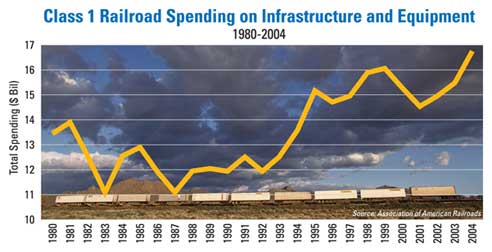
SEPTEMBER 2005
Passing the Torch (cover)
Niche Airport Boosts Middle East Logistics
O'Hare Expansion Clears Another Hurdle
Global Trade Spurs
Bevy of Port Projects
Other Ports Reach Another Level
Road and Rail,
Both on Rise, Seek Ways to Converge
Rail Activity
Not So Skinny
Intermodal Central to Movement's Future
Volume Separators; Want Big Numbers? Think Small
Request Information

INFRASTRUCTURE REPORT 2005
Rail Activity Not So Skinny
Asia is also the site of pronounced rail project investment, not just in the passenger-heavy corridors around Hong Kong and southern China, but also the coal-heavy corridors leading from Inner Mongolia to the outer provinces. Inner Mongolia possesses more than 22 percent of China's coal reserves, or 223.4 billion tons.
In The Netherlands, a booming logistics and industrial scene is stoking development of the Betuweroute, a 100-mile (160-km.) double-track freight line between the growing port of Rotterdam and Zevenaar-Emmerich at the German border. The US$5.5-billion project is expected to be complete in 2006, when Europe's freight railway network is deregulated. Among the project's components is an increase in capacity at the Kijfhoek Shunting Yards from 1,600 cars to 2,800 cars per day, including a "flyover" element that allows port trains to bypass the yards.

|
That project is part of a bigger project: The Trans European Freight Rail Network's aim is to eventually allow total EU freight train access without having to yield to passenger trains or stop at borders. That works for railway companies like Railion, Europe's largest and part of the Stinnes Group. The railroad is investing in a four-year program ending in 2006, including 500 locomotives ready for international deployment.
Back in the U.S., a major section of the new transportation legislation is entitled "National Corridor Infrastructure Improvement Program," and includes provisions for funding border-zone infrastructure and freight intermodal connectors, as well as dedicated truck lanes. It also instructs the Office of Intermodalism to perform a National Intermodal System Improvement Plan, with its first report due in 2007. Meanwhile, the bill's grant program for rail line relocation projects — such as those making headlines in Texas — is coming through with $350 million in funds, at least half of which will be awarded in increments not to exceed $20 million.
Any amount will be welcome in an industry that is bearing the lion's share of cost for infrastructure upgrades and improvements through private means. One estimate pegs that private reinvestment at 17 cents per revenue dollar, higher than even the power industry.
Yet extremely high freight demand is boosting profits at the same time it pushes the system's limits. In late July, Union Pacific, Burlington Northern Santa Fe, CSX and Norfolk Southern all posted major profit gains due to rising demand and rising rates.